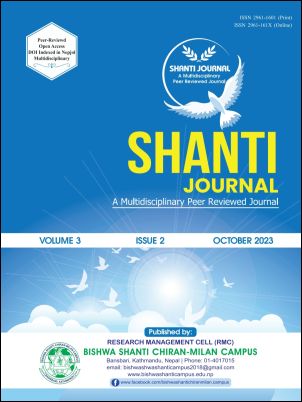Subjectivity in Prateek Dhakal’s Parikrama Annapurna
DOI:
https://doi.org/10.3126/shantij.v3i1-2.60884Keywords:
Niyatra, travel writing, individuality, travel, imaginationAbstract
Travel writing specially niyatra is becoming popular globally for introducing the hidden culture and location by travelers’ point of view. This research focuses on Prateek Dhakal’s Parikrama Annapurna as niyatra, a travel writing in which the writer expresses his experiences and emotions he has had during the travel. The study helps to promote Nepali niyatra literature globally and make the mountains of Nepal as described in Dhakal’s niyatra known to the world. Dhakal informs the readers about the hills and mountains of Nepal and describes how beautiful are the trekking trails for the nature lover to roam around the snow filled mountains. He explains the readers about the experiences of trekking in the Himalayas. The major objective of the research is to show how the writer’s personality appears in niyatra. For this, the theoretical approach of Byaas, Thompson and Blanton on niyatra literature are used. All of these theorists claim that writers involve in the travel and express their personal thoughts, feelings and emotions they have had during the travel in the writing. The writer steps out of home alone or with friend or friends and completes the travel by the means of transportation or on foot. Several evidences of writer’s appearance in niyatra are presented in the findings. Regarding methodology, the study draws the insights of travel writing and specially niyatra literature of Byaas, Thompson and Blanton as a theoretical framework and adopts descriptive research design for pointing out the voice of author, expression of his self, emotions, experiences and personal matters in the course of travel as conceptual framework. The major findings of the study are that Dhakal goes on trekking with the friends in Annapurna circuit, feels and experiences many things personally, watches mountains and hills and expresses his views and ideas in the text. The main conclusion of the research is that Dhakal expresses his self in the text and his appearance is dominant in Parikrama Annapurna. The text is a travel writing in which the personality of the writer is visible, his voice, feelings, emotions, and personal matters are audible. For the further researcher, use of imagination in travel writing can be another area to investigate in the text.
Downloads
Downloads
Published
How to Cite
Issue
Section
License
Copyright (c) 2023 The Author(s)

This work is licensed under a Creative Commons Attribution-NonCommercial 4.0 International License.
This license enables reusers to distribute, remix, adapt, and build upon the material in any medium or format for noncommercial purposes only, and only so long as attribution is given to the creator.




